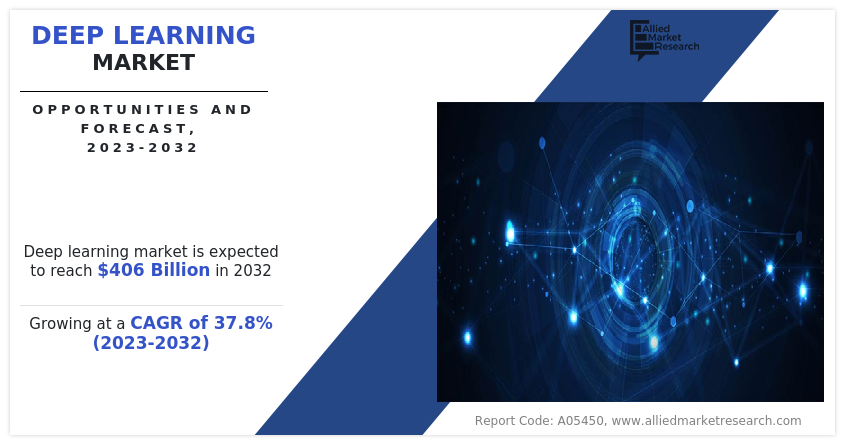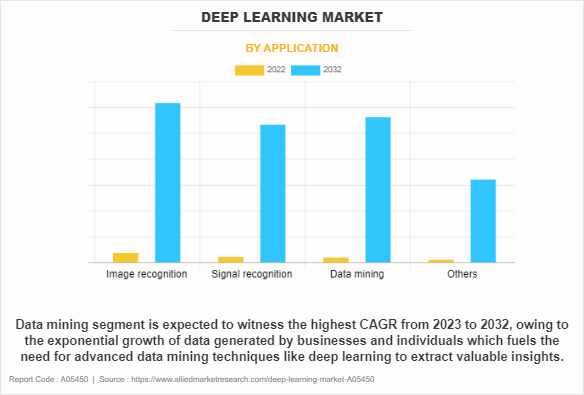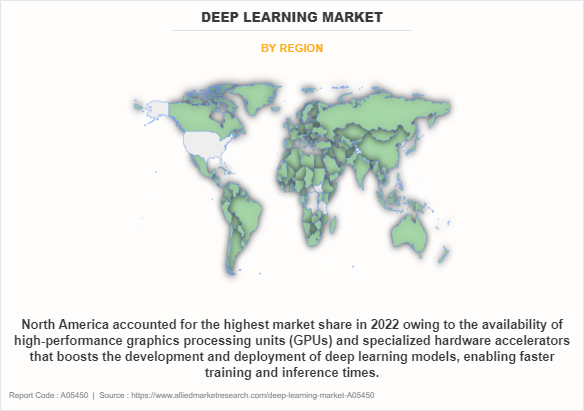Deep Learning Market Size & Share:
The global deep learning market size was valued at USD 16.9 billion in 2022, and is projected to reach USD 406 billion by 2032, growing at a CAGR of 37.8% from 2023 to 2032.
The key factors that drive the growth of deep learning market include improving continuing power along with declining hardware cost and increasing adoption of cloud-based technology. Growing organizational demand for processing power and the deployment of Internet of Things (IoT) devices across a variety of industries are driving deep learning market growth. In addition, 2.5 quintillion bytes of new data are generated daily, and that figure is rising. Huge amounts of data generated by numerous industry sectors are creating profitable opportunities for deep learning solutions to give businesses effective, adaptable, and scalable insights.

Furthermore, to assist clients, extract the information they require from a large dataset, cloud analytics combines technological, infrastructural, and analytical tools and methodologies. In addition, cloud-based deep learning analytics aid organizations in lowering their infrastructure and storage costs as well as operational expenditures. The report focuses on growth prospects, restraints, and trends of the deep learning industry analysis. The study provides Porter’s five forces analysis to understand the impact of various factors, such as bargaining power of suppliers, competitive intensity of competitors, threat of new entrants, threat of substitutes, and bargaining power of buyers, on the deep learning market.
Deep learning is a kind of artificial intelligence and machine learning technology that imitates human behavior to generate human brain cells-generated information. The technology is useful in performing classification tasks and recognizing patterns in photos, text, audio, and other data. In addition, it is utilized to automate jobs that ordinarily call for human intellect, such as annotating photographs and transcribing audio files.
Top Impacting Factors:
Improving Computing Power and Declining Hardware Cost
Growing organizational demand for processing power and the deployment of IoT devices across a variety of industries are driving market expansion. In addition, 2.5 quintillion bytes of new data are generated daily, and that figure is rising. Huge amounts of data generated by numerous industry sectors are creating profitable opportunities for deep learning solutions to give businesses effective, adaptable, and scalable insights. Furthermore, the banking, financial services, and insurance (BFSI) industry held the largest deep learning market share in 2020 due to the industry high production of sensitive data, rising cyberattack rate, and emphasis on customer data security and legal compliance, all of which contribute to the growth of deep learning industry.
Increasing Adoption of Cloud-based Technology
Cloud-analytics is the amalgamation of technological, infrastructural, and analytical tools and techniques to help clients drive necessary information from a massive dataset. In addition, cloud-based deep learning analytics helps institutes to reduce their operational costs as well as to reduce infrastructure and storage costs of the organization. Furthermore, cloud-based deep learning analytics offers institutes superior security and provides enhanced safety to critical data of an organization, which provides lucrative opportunities for the deep learning market.
In addition, cloud computing also helps institutes in analyzing large quantities of data sets and enhance their analytics skill, which propels the demand for deep learning in the future. Furthermore, the rapid adoption of connected devices across various education institutes and government initiatives to increase digitization across the industry vertically propels the growth of the deep learning market. For instance, in July 2020, the Australian Catholic University (ACU) turned its newly united data environment into a data lake to provide a single view of student development. It uses Microsoft’s Power BI and Azure data platform to support students who may need extra help or who are at risk of dropping out of the university entirely. Thus, this is considered as an important factor driving the growth of the market.
Segment Review:
The deep learning market is segmented on the basis of component, application, industry vertical, technology, and region. In terms of components, the market is bifurcated into hardware, software, and service. By application, the market is divided into image recognition, signal recognition, data mining, and others. Based on industry vertical, it is divided into security, marketing, automotive, retail & e-commerce, healthcare, manufacturing, law, and others. On the basis of region, it is analyzed across North America, Europe, Asia-Pacific, and LAMEA.

On the basis of application, data mining segment is expected to exhibit fastest CAGR during the deep learning market forecast. This is attributed to the fact that deep learning models can automatically recognize complex patterns, relationships, and correlations in data. This is particularly beneficial for data mining tasks like fraud detection, image recognition, and natural language processing.

On the basis of region, North America dominated the deep learning market size in the year 2022. This is because of high investments and the availability of settled IT infrastructure in the region.
The report analyzes the profiles of key players operating in the deep learning market such as Advanced Micro Devices Inc., Amazon Web Services Inc., Google LLC, IBM Corporation, Intel Corporation, Microsoft Corporation, NVIDIA Corporation, Qualcomm Technologies, Inc., Samsung, and Xilinx. These players have adopted various strategies to increase their market penetration and strengthen their position in the deep learning industry.
Regional Insights:
North America: North America remains a dominant force in the deep learning market, driven by the presence of leading tech companies and extensive R&D in AI and machine learning. The U.S. has made significant investments in AI-driven solutions, particularly in sectors like healthcare, automotive, and finance. For example, the adoption of deep learning in autonomous vehicles and the healthcare diagnostics sector has surged due to increasing demand for precision and automation. The region's robust cloud infrastructure, coupled with support from government initiatives like the National AI Initiative Act, further boosts deep learning market growth.
Europe: Europe is rapidly integrating deep learning into its industrial landscape, focusing on manufacturing, healthcare, and transportation sectors. Governments across the region have introduced initiatives to support AI and machine learning technologies. Countries like Germany and the UK are heavily investing in AI research centers. The EU’s "AI Act" proposal, introduced in April 2021, is expected to regulate AI applications, fostering innovation while ensuring compliance with ethical standards. Europe's advancements in Industry 4.0 also make it a key player in adopting deep learning technologies for smart manufacturing.
Asia-Pacific: The Asia-Pacific region is experiencing rapid growth in the deep learning market, with China, Japan, and South Korea at the forefront. China’s government has set a target of becoming a global AI leader by 2030, promoting large-scale adoption of AI technologies in various industries such as e-commerce, healthcare, and smart cities. India is also emerging as a significant player, leveraging deep learning in areas like agriculture, telecommunications, and government services. The region's focus on digital transformation and AI-driven initiatives, such as South Korea’s AI National Strategy, is helping fuel deep learning market growth.
Middle East & Africa: The adoption of deep learning technologies is still in its early stages in the Middle East and Africa, but increasing investments in AI infrastructure are evident. Countries like the UAE and Saudi Arabia are actively exploring the use of AI for smart cities, energy management, and healthcare. The UAE’s AI strategy launched in 2017 continues to push for widespread adoption of AI and deep learning technologies across sectors. Additionally, African countries are leveraging deep learning to address challenges in agriculture and education, aided by partnerships with global technology firms.
Latin America: Latin America is gradually adopting deep learning technologies, primarily in financial services, healthcare, and retail sectors. Brazil, Mexico, and Argentina are leading this transformation. The increasing penetration of mobile technology and digital services is encouraging the adoption of AI-powered applications. In Brazil, deep learning is used in fintech for fraud detection and customer behavior analysis. Governments in the region are also exploring AI for public services, such as smart city initiatives, to improve urban planning and sustainability efforts.
Key Industry Developments:
April 2023 - Nvidia announced the launch of its H100 Tensor Core GPU, designed specifically for deep learning tasks. This powerful chip is expected to revolutionize AI computing and push deep learning capabilities to new levels, enhancing applications in industries ranging from autonomous driving to healthcare diagnostics. Nvidia’s hardware is widely used in data centers across North America, Asia-Pacific, and Europe, significantly impacting the global deep learning ecosystem.
August 2023 - Alphabet's DeepMind announced an expansion into new research areas, including drug discovery and quantum computing. This move is expected to accelerate advancements in the healthcare and pharmaceutical sectors by leveraging deep learning models to predict molecular structures and interactions. DeepMind's ongoing collaboration with European pharmaceutical companies highlights Europe’s pivotal role in using AI to advance medical research.
March 2024 - Baidu launched new AI cloud services focused on deep learning and big data analytics. The initiative aims to accelerate China’s digital transformation, focusing on sectors like e-commerce, autonomous driving, and healthcare. Baidu’s advanced AI solutions are being widely adopted across Asia-Pacific, helping companies enhance operational efficiency and customer experience using deep learning technologies.
Market Landscape and Trends:
The expansion of deep learning market is driven by various trends such as continued advances in model architectures, pre-trained models with transfer learning, and explainable artificial intelligence (XAI). Researchers are continuously developing and refining deep neural network architectures to improve performance and efficiency. This includes innovations in convolutional neural networks (CNNs), recurrent neural networks (RNNs), transformers, and more.
Furthermore, the use of pre-trained models for transfer learning is becoming increasingly popular. These models, trained on massive datasets, are fine-tuned for specific tasks, reducing the need for large amounts of labeled data. Moreover, there is a growing emphasis on making deep learning models more interpretable and explainable, as AI systems are applied to critical domains, to understand the reasoning behind model decisions.
Key Benefits for Stakeholders:
- This report provides a quantitative analysis of the market segments, current trends, estimations, and dynamics of the deep learning market forecast from 2022 to 2032 to identify the prevailing market opportunities.
- Market research is offered along with information related to key drivers, restraints, and opportunities of deep learning market outlook.
- Porter's five forces analysis highlights the potency of buyers and suppliers to enable stakeholders to make profit-oriented business decisions and strengthen their supplier-buyer network.
- In-depth analysis of the deep learning market segmentation assists in determining the prevailing deep learning market opportunity.
- Major countries in each region are mapped according to their revenue contribution to the global market.
- Market player positioning facilitates benchmarking and provides a clear understanding of the present position of the market players.
- The report includes an analysis of the regional as well as global deep learning market trends, key players, market segments, application areas, and market growth strategies.
Deep Learning Market Report Highlights
| Aspects | Details |
| Market Size By 2032 | USD 406 billion |
| Growth Rate | CAGR of 37.8% |
| Forecast period | 2022 - 2032 |
| Report Pages | 350 |
| By Component |
|
| By Application |
|
| By Industry Vertical |
|
| By Region |
|
| Key Market Players | Xilinx, Qualcomm Technologies, Inc. , Google LLC, NVIDIA Corporation, Advanced Micro Devices Inc.(Xilinx Inc.), Intel Corporation, IBM Corporation, Samsung, Amazon Web Services, Inc., Microsoft Corporation |
Analyst Review
The adoption of deep learning has a profound impact on the ICT sector revolutionizing various aspects of the industry. The technology accounts for numerous uses in the ICT industry such as image and video analysis, natural language processing (NLP), speech recognition, recommendation systems, healthcare, finance, autonomous systems, manufacturing and industry, energy management, cybersecurity, supply chain management and virtual reality (VR)/augmented reality (AR). The technology helps in object detection, image classification, facial recognition, and video content understanding. This is particularly useful in areas like surveillance, autonomous vehicles, medical imaging, and entertainment. In addition, the technology enables better language understanding, sentiment analysis, language translation, text generation, chatbots, and others. These advancements have transformed customer support, content generation, and language-related services. Furthermore, deep learning is at the core of many state-of-the-art speech recognition systems, making voice interfaces more accurate and versatile. This technology is crucial for virtual assistants, voice commands, transcription services, and others.
The CXOs further added that market players are adopting strategies like partnership for enhancing their services in the market and improving customer satisfaction. For instance, in June 2023, Microsoft Corporation collaborated with HCL Technologies Inc. to expand their strategic partnership to assist enterprises leverage generative artificial intelligence (AI) and develop joint solutions to enable businesses to achieve and enhance business transformation. In addition, in March 2023, Qualcomm Technologies Inc. collaborated with Ying Wu College of Computing to produce a federated learning system and zone federated learning the first end-to-end, mobile cloud federated learning systems that function on smartphones. Therefore, such strategies are expected to boost the growth of the deep learning market in the upcoming years.
The global deep learning market size was valued at USD 16.9 billion in 2022, and is projected to reach USD 406 billion by 2032
The deep learning market is estimated to grow at a CAGR of 37.8% from 2023 to 2032.
The key players profiled in the report include deep learning market analysis includes top companies operating in the market such as Advanced Micro Devices Inc., Amazon Web Services, Inc., Google LLC, IBM Corporation, Intel Corporation, Microsoft Corporation, NVIDIA Corporation, Qualcomm Technologies, Inc., Samsung and Xilinx.
As of 2024, North America stands as the largest regional market for deep learning, accounting for approximately 33.6% of global revenue.
Key drivers of deep learning market growth include rising computing power, falling hardware costs, cloud adoption, growing demand for processing power, and widespread IoT deployment across industries.
Loading Table Of Content...
Loading Research Methodology...



